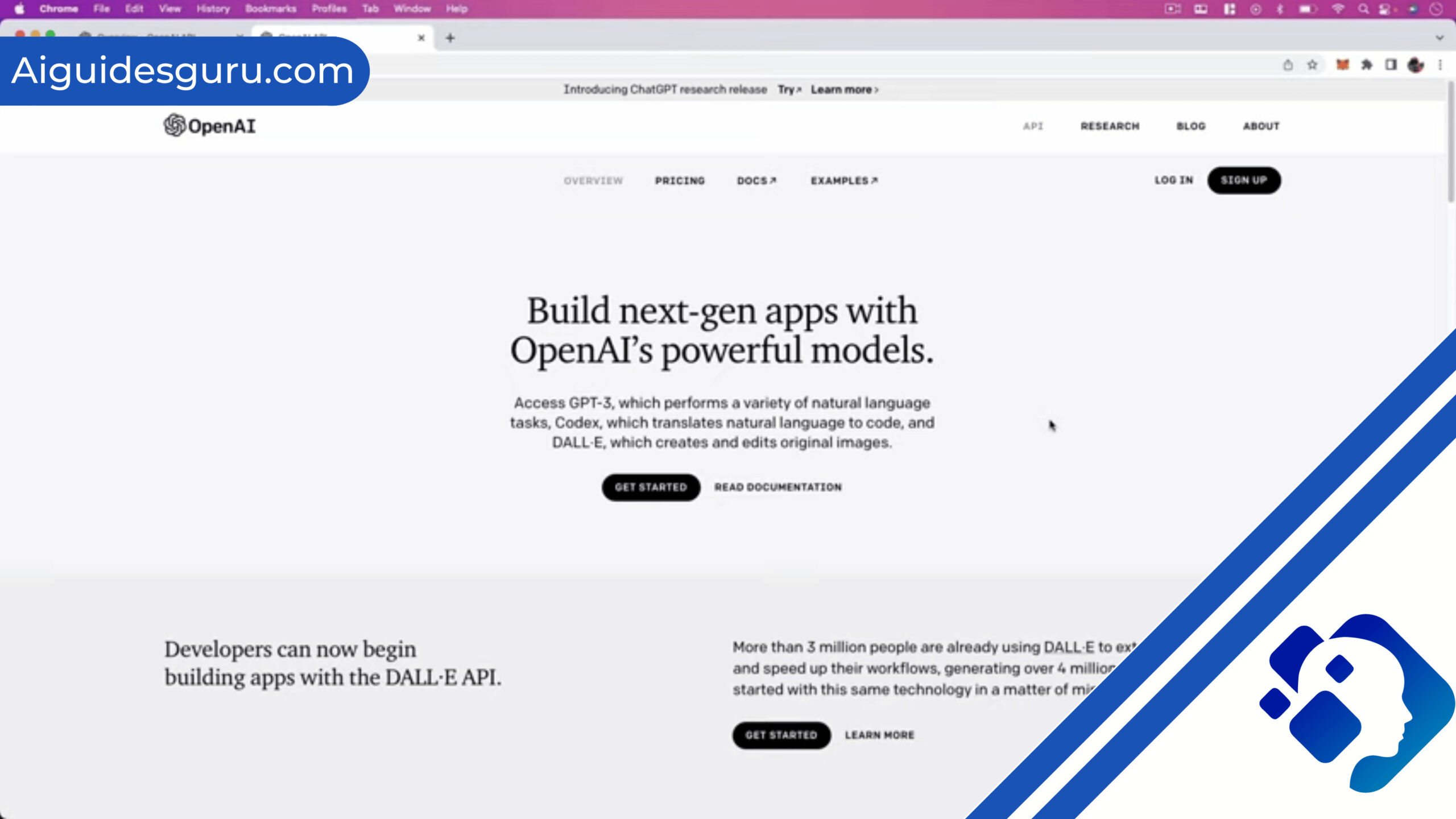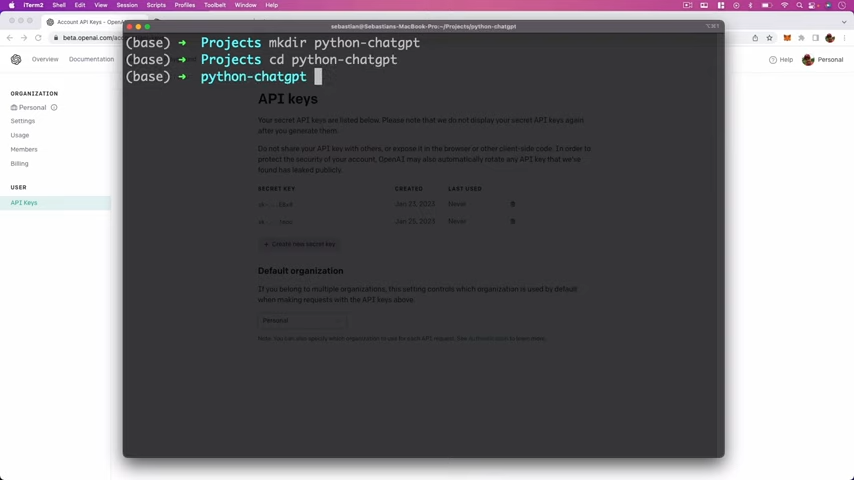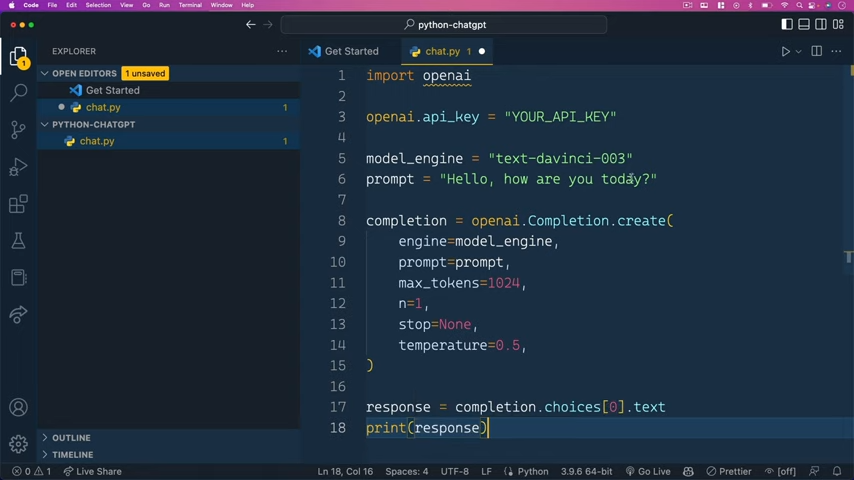How to Use ChatGPT API with Python

In today’s tech-driven world, artificial intelligence (AI) and natural language processing (NLP) have become integral to creating engaging and dynamic user experiences. One of the most powerful tools in this domain is ChatGPT, an advanced language model developed by OpenAI. ChatGPT can generate human-like text and engage in fluent conversations that are often indistinguishable from those with a human. OpenAI has made it easier for developers to integrate ChatGPT into their applications by providing an API. In this comprehensive guide, we will explore how to use the Chat GPT API with Python.
1. Introduction to Chat GPT API
- 1. Introduction to Chat GPT API
- 2. Setting Up the Development Environment
- 3. Generating an API Key
- 4. Installing the OpenAI API Client
- 5. Initializing the ChatGPT Client
- 6. Interacting with ChatGPT
- 7. Creating a Chatbot with ChatGPT API in Python
- 8. Examples of Using ChatGPT in Python Code
- 9. Evaluating the Generated Code
- 10. Best Practices and Tips for Using ChatGPT API
- 11. Integration Ideas for ChatGPT API
- 12. Conclusion
- FAQs
ChatGPT API is a powerful tool provided by OpenAI that allows developers to integrate ChatGPT into their Python applications. With ChatGPT API, you can harness the capabilities of ChatGPT to generate human-like text and engage in dynamic conversations. Whether you want to create a chatbot, automate customer support, or generate code snippets, ChatGPT API can be a valuable asset.
2. Setting Up the Development Environment
Before we dive into using ChatGPT API with Python, let’s ensure that we have the necessary tools and environment set up. Firstly, make sure you have Python 3.7 or newer installed on your system. If Python is not already installed, you can download it from the official Python website (python.org). Additionally, you will need an OpenAI API key to access the ChatGPT API.
3. Generating an API Key
To use the ChatGPT API, you need to generate an API key from OpenAI. Here are the steps to follow:
- Sign up or log in to your account on the OpenAI website.
- Navigate to the API Keys section and click on “View API Keys.”
- Click on “Create New Secret Key.”
- Give your key a unique name and click “Create New Key.”
- Copy the generated secret key and save it securely. This key will be required later in the development process.
Related: How Many Questions Can You Ask ChatGPT in an Hour?
4. Installing the OpenAI API Client
To interact with the ChatGPT API, we need to install the OpenAI API client. We can do this using the Python package manager, pip. Open a terminal or command prompt and enter the following command:
pip install openai
This command will download and install the OpenAI API client on your system.

5. Initializing the ChatGPT Client
With the OpenAI API client installed, we can now initialize the ChatGPT client in our Python application. This involves importing the necessary libraries and setting the API key. Here’s an example of how to initialize the ChatGPT client:
import openai
openai.api_key = 'YOUR_API_KEY'
Replace ‘YOUR_API_KEY’ with the API key you generated in step 3.
6. Interacting with ChatGPT
Now that we have set up the development environment and initialized the ChatGPT client, we can start interacting with ChatGPT. The ChatGPT API allows us to send prompts or questions to the model and receive generated responses.
To interact with ChatGPT, we can use the openai.Completion.create() method. Here’s an example of how to use it:
response = openai.Completion.create(
model="gpt-3.5-turbo",
prompt="What is the meaning of life?",
max_tokens=50,
n=1,
stop=None,
temperature=0.7
)
answer = response.choices[0].text.strip()
print(answer)
In this example, we provide a prompt or question to the model and specify the model to use (in this case, gpt-3.5-turbo). We also set parameters such as the maximum number of tokens in the response, the number of responses to generate (n), the stop sequence (if any), and the temperature for controlling the randomness of the output.
7. Creating a Chatbot with ChatGPT API in Python
One of the popular applications of ChatGPT is creating chatbots. With ChatGPT API and Python, you can easily build a chatbot that can engage in conversations with users. Here’s an example of how to create a simple chatbot using the ChatGPT API:
import openai
openai.api_key = 'YOUR_API_KEY'
def chat_with_chatbot(question):
response = openai.Completion.create(
model="gpt-3.5-turbo",
messages=[
{"role": "system", "content": "You are a helpful assistant."},
{"role": "user", "content": question}
]
)
return response.choices[0].text.strip()
while True:
user_input = input("User: ")
answer = chat_with_chatbot(user_input)
print("Chatbot:", answer)
In this example, we define a function chat_with_chatbot() that takes a user’s question as input and uses the ChatGPT API to generate a response. The function sets up a conversation with the chatbot by providing system and user messages. The response from the API call is then returned and printed as the chatbot’s answer.
8. Examples of Using ChatGPT in Python Code
ChatGPT can be used for more than just generating text. It can also assist in writing code snippets, solving complex algorithms, and automating tasks. Here are a few examples of how you can use ChatGPT in Python code:
Related: How to Bypass ChatGPT Detector
Example 1: Generating Code for Web Scraping
Web scraping is a common task in data extraction and analysis. With ChatGPT, you can generate code snippets for web scraping tasks. Here’s an example of how to generate code for web scraping using ChatGPT:
question = "Generate Python code to scrape the titles of articles from a webpage."
response = chat_with_chatbot(question)
print(response)
The generated response from ChatGPT will provide you with a code snippet that you can use for web scraping.
Example 2: Writing Complex Algorithms
ChatGPT can also assist in writing complex algorithms. By providing a prompt or problem statement, you can ask ChatGPT to generate code for solving algorithms. Here’s an example:
question = "Write Python code to find the factorial of a number."
response = chat_with_chatbot(question)
print(response)
The generated response will provide you with the code for finding the factorial of a number.
Example 3: Automating Data Analysis Tasks
Data analysis often involves repetitive tasks that can be automated. With ChatGPT, you can generate code snippets to automate data analysis tasks. Here’s an example:
question = "Generate Python code to calculate the average of a list of numbers."
response = chat_with_chatbot(question)
print(response)
The generated response will provide you with the code for calculating the average of a list of numbers.

9. Evaluating the Generated Code
While ChatGPT can generate code snippets, it’s important to evaluate and test the generated code before using it in production. The generated code may not always be optimal or error-free. It’s recommended to review and modify the code as needed, and ensure that it meets your specific requirements and follows best practices.
10. Best Practices and Tips for Using ChatGPT API
When using the ChatGPT API with Python, consider the following best practices and tips:
- Start with a system message: Provide a system message at the beginning of the conversation to guide the behavior of the chatbot.
- Limit response length: Set a maximum token limit to control the length of responses generated by ChatGPT.
- Experiment with temperature: Adjust the temperature parameter to control the randomness of the generated responses.
- Iterate and refine: Test and iterate on your prompts and conversations to improve the quality of the generated responses.
- Review and modify generated code: Always review and modify the generated code to ensure it meets your requirements and follows best practices.
11. Integration Ideas for ChatGPT API
The ChatGPT API can be integrated into a wide range of applications and use cases. Here are a few ideas to get you started:
- Customer support chatbots: Use ChatGPT to provide automated customer support and answer frequently asked questions.
- Code generation: Generate code snippets for specific tasks or automate repetitive coding tasks.
- Content generation: Use ChatGPT to generate blog posts, articles, or creative writing pieces.
- Virtual assistants: Build virtual assistants that can engage in natural language conversations and perform tasks.
12. Conclusion
In this comprehensive guide, we have explored how to use the ChatGPT API with Python. We learned how to set up the development environment, generate an API key, install the OpenAI API client, and initialize the ChatGPT client. We also discovered how to interact with ChatGPT, create a chatbot, and use ChatGPT for generating code snippets and automating tasks. By following best practices and experimenting with prompts and conversations, you can leverage the power of ChatGPT to enhance your applications and create engaging user experiences.
To learn more about ChatGPT and its capabilities, refer to the official OpenAI documentation and explore the possibilities of integrating ChatGPT into your own projects.
FAQs
1. Can I use ChatGPT API for free?
ChatGPT API is not available for free. OpenAI offers different pricing plans for accessing the ChatGPT API. You can refer to the OpenAI pricing page or contact OpenAI for more information about the pricing details.
2. How accurate are the responses generated by ChatGPT?
The accuracy of the responses generated by ChatGPT can vary. While ChatGPT is trained on a large dataset and designed to generate human-like text, it may still produce incorrect or nonsensical answers. It’s important to review and evaluate the generated responses before using them in production.
3. Is ChatGPT suitable for all types of applications?
ChatGPT can be a valuable tool for a wide range of applications, including chatbots, customer support, content generation, and code automation. However, it may not be suitable for applications that require highly specialized or domain-specific knowledge. It’s important to consider the limitations and capabilities of ChatGPT when integrating it into your applications.
4. How can I improve the quality of the generated responses?
To improve the quality of the generated responses, you can experiment with different prompts, adjust the temperature parameter to control randomness, and iterate on your conversations. Providing clear and specific prompts can also help in obtaining more accurate and relevant responses from ChatGPT.
5. What are some alternative AI models similar to ChatGPT?
There are several AI models similar to ChatGPT that you can explore, such as GPT-3, GPT-2, and Transformer models. Each model has its own strengths and limitations, so it’s important to evaluate and choose the model that best suits your specific requirements.







